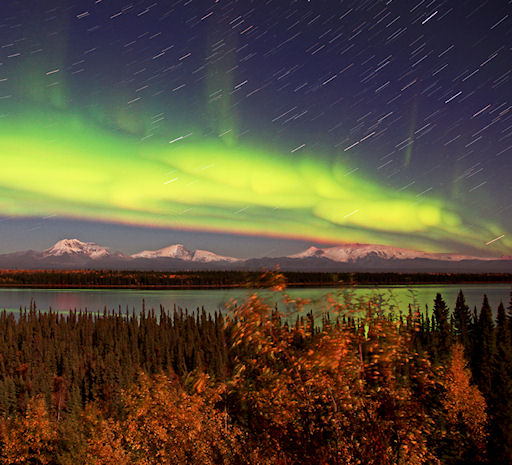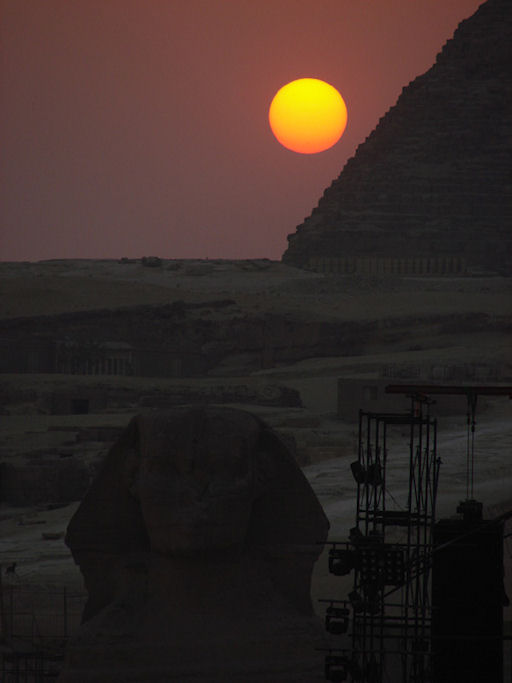AURORA ALERTS: Did you miss the Northern Lights? Next time get a wake-up call from Space Weather PHONE | | |
ROCKET LAUNCH ALERT: Sky watchers in southern Califonia should be alert for a rocket blasting off from Vandenberg AFB on Saturday, Sept. 25th, at 9:41 pm PDT, the start of a 9:41 to 9:55 p.m. launch window. Carrying a military space surveillance satellite, the Minotaur IV booster will climb vertically, then turn slowly to the south, putting on a show that could be visible as far away as Reno and San Francisco. [more]
NORTHERN LIGHTS: The solar wind is gaining speed as it buffets Earth's magnetic field for the second day in a row. Bright moonlight, however, is overwhelming all but the brightest auroras. Traveling through Alaska, British photographer Paul Alsop is hoping for another display like this:

"I came to Alaska from Newcastle upon Tyne, England, to see the Northern Lights--and I was not disappointed," says Alsop. "On Sept. 21st the lights danced and shimmered across the sky like a laser show. At one point the auroras formed what looked like a dragon's head, then it melted away. It was just wonderful."
NOAA forecasters estimate a 25% chance of geomagnetic activity tonight. High-latitude sky watchers should remain alert for auroras.
Sept. 2010 Northern Lights Gallery
[previous Septembers: 2009, 2008, 2007, 2006, 2005, 2004, 2002, 2001, 2000]
EGYPTIAN SUNSET: Yesterday in Giza, Egypt, Aymen Ibrahem positioned himself in front of the Pyramid of King Khephren to photograph the sunset. "Every year, just after the autumnal equinox, the sun sets directly behind the east-west aligned Sphinx," he explains. "This would be a great photo-op." His pictures, however, revealed more than he expected. Scroll down below the Sphinx to find out what he saw.

"When I took a closer look at the images, I found two sunspots," he says. Indeed, sunspots 1108 and 1109 are large enough to see without the amplification of a solar telescope. "Drifting clouds and the dusty air lowered the brightness of the sun enough for me to capture them using nothing more than my camera (a Sony DSC H5)."
more images: from Frans Zietsman of Fourways, Johannesburg, South Africa
a cautionary note: Never look at the sun through the viewfinder of a camera or unfiltered telescope. Even when the sun is dimmed by haze or clouds, sunlight magnified by optics can damage your eyes, resulting in temporary or permanent blindness. Play it safe: use the camera's LCD screen to preview the scene.
Potentially Hazardous Asteroids (
PHAs) are space rocks larger than approximately 100m that can come closer to Earth than 0.05 AU. None of the known PHAs is on a collision course with our planet, although astronomers are finding
new ones all the time.
On September 25, 2010 there were 1145 potentially hazardous asteroids.
Notes: LD means "Lunar Distance." 1 LD = 384,401 km, the distance between Earth and the Moon. 1 LD also equals 0.00256 AU. MAG is the visual magnitude of the asteroid on the date of closest approach. | | The official U.S. government space weather bureau |
| | The first place to look for information about sundogs, pillars, rainbows and related phenomena. |
| | Researchers call it a "Hubble for the sun." SDO is the most advanced solar observatory ever. |
| | 3D views of the sun from NASA's Solar and Terrestrial Relations Observatory |
| | Realtime and archival images of the Sun from SOHO. |
| | from the NOAA Space Environment Center |
| | from the National Solar Data Analysis Center |

